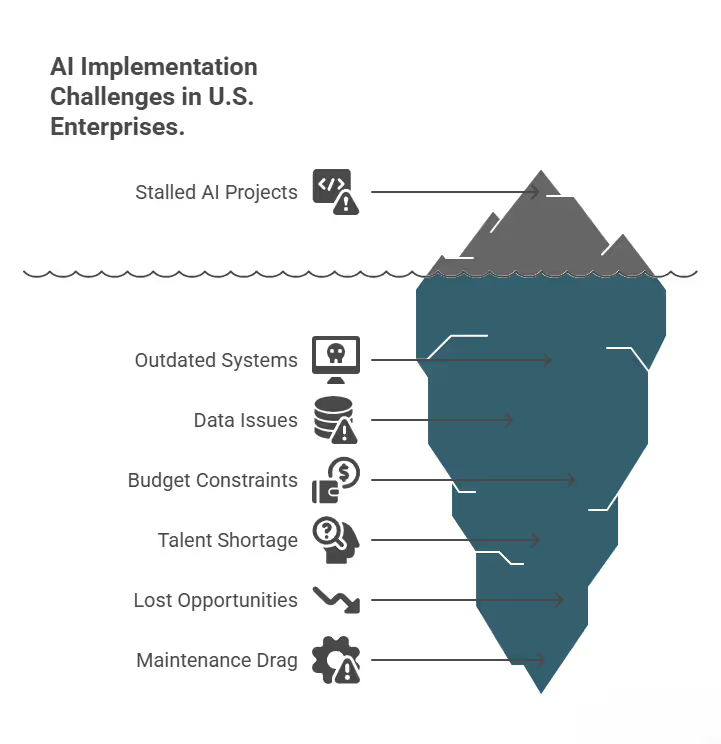Generative AI Implementation in Legacy Systems

What Is Generative AI Implementation in Legacy Systems?
- Generative AI implementation in legacy systems means embedding AI models into older IT platforms.
- It modernizes ERP, mainframes, and healthcare IT without full replacement.
- Benefits include automation, efficiency, compliance, and innovation.
Legacy systems, such as ERP platforms, mainframes, and healthcare record software, remain the backbone of many U.S. enterprises. These systems often manage mission-critical processes but lack the flexibility, speed, and intelligence required for today’s business demands. Replacing them outright is risky and costly, so many CIOs are turning to Generative AI implementation as a modernization strategy.
At its core, generative AI implementation involves integrating advanced AI models into existing legacy systems to enhance functionality without rewriting the entire infrastructure. For example, in ERP systems, generative AI can automate report creation, optimize inventory predictions, and assist in financial forecasting. In mainframe environments, AI can streamline batch processing, improve error detection, and provide conversational interfaces for complex query handling. In healthcare IT systems, generative AI enhances patient data interpretation, assists in clinical documentation, and supports predictive analytics for better care outcomes.
Unlike traditional modernization approaches that require “rip-and-replace” methods, generative AI allows incremental upgrades. CIOs can deploy AI-powered copilots, intelligent chat interfaces, and process automation tools while keeping the existing system intact. This balance of innovation with stability is why U.S. enterprises across finance, healthcare, and manufacturing see generative AI as a safer, faster modernization pathway.
In short, generative AI implementation in legacy systems bridges the gap between old infrastructures and new digital transformation needs—making outdated platforms smarter, more efficient, and future-ready

Why U.S. Enterprises Are Adopting Generative AI for Legacy Systems
The adoption of generative AI in legacy environments is growing rapidly in the U.S., driven by a combination of economic, regulatory, and competitive pressures. For CIOs and IT leaders, the business case centers around four major drivers:
- Cost Savings: Replacing legacy systems like mainframes or ERP platforms can cost millions of dollars and take years. Generative AI reduces costs by extending the system’s life and automating manual processes. For example, banks use AI to automate compliance checks instead of investing in new core banking systems.
- Innovation: U.S. enterprises are under pressure to deliver innovative services faster. Generative AI enables intelligent document handling, predictive analytics, and customer-facing virtual assistants—all layered on top of existing legacy IT without massive disruption.
- Compliance & Risk Management: Highly regulated industries such as healthcare and finance benefit from generative AI’s ability to improve auditing, reporting, and error detection. In healthcare, AI-assisted EHR (Electronic Health Records) tools help meet HIPAA requirements while reducing physician workload.
- Digital Transformation: Digital-first competitors are disrupting traditional industries. Generative AI provides U.S. manufacturers, banks, and hospitals with tools to modernize operations while staying competitive in the era of Industry 4.0 and AI-driven care.
The U.S. context makes adoption even more urgent:
- Labor shortages in healthcare and manufacturing push enterprises to automate routine tasks.
- Banking modernization demands AI for fraud detection, compliance, and customer service improvements.
- Healthcare IT must evolve to manage growing patient data while meeting privacy regulations.
By layering generative AI on top of legacy infrastructure, U.S. enterprises gain the agility of modern IT without the risks of starting from scratch. This makes AI not just an enhancement, but a strategic necessity for organizations looking to survive and thrive in a rapidly evolving digital economy.
Step-by-Step Generative AI Implementation in Legacy Systems
A clear AI implementation roadmap keeps things on track. I’ve used this plan to launch AI for U.S. clients across retail, finance, and healthcare.
Step 1: Assess and Strategize
Start with a reality check:
- Audit systems: Spot gaps in data or compute.
- Pick use cases: Focus on high-ROI like predictive maintenance.
- Define metrics: Aim for 20% cost cuts or 15% revenue gains.
- Get buy-in: Align with U.S. execs on goals.
This sets up AI infrastructure planning.
Step 2: Lay the Foundation
Build the tech base:
- Upgrade pipelines: Enable real-time data flows.
- Containerize: Use Kubernetes for AI workloads.
- Set governance: Roll out security and data policies.
- Train teams: Start AI skill-building.
This follows AI architecture best practices.
Step 3: Test and Refine
Pilot to prove value:
- Launch pilots: Try AI in customer support or logistics.
- Track KPIs: Measure accuracy or time savings.
- Tweak based on feedback: Adjust models or data.
- Document wins: Build a scaling playbook.
Pilots showcase AI ROI.
Step 4: Scale Across the Enterprise
Go big:
- Expand pilots: Apply AI to supply chains or marketing.
- Optimize: Tune infrastructure for efficiency.
- Form AI councils: Oversee strategy and ethics.
- Plan ahead: Prep for generative AI or edge computing.
This ensures enterprise AI transformation sticks.
Proving Generative AI’s Implementation Worth with Metrics for Legacy Applications
AI ROI keeps the C-suite happy. I’ve helped U.S. clients like a Miami hotel chain quantify AI’s impact.
Track these metrics.
How Do You Measure Tech Gains?
Infrastructure improvements matter:
- Speed: 40% faster AI inference times.
- Uptime: 99.9% system reliability.
- Cost savings: 25% lower cloud spend.
- Security: 50% fewer incidents.
These validate AI infrastructure modernization.
What Business Wins Can You Show?
Quantify real impact:
- Automation: $1M saved yearly on manual tasks.
- Revenue: 10% sales lift from AI recommendations.
- Customer NPS: 15-point boost from AI chatbots.
- Accuracy: 90% hit rate on demand forecasts.
These align with enterprise AI transformation strategies.
How Do You Track Cultural Shifts?
Adoption is key:
- Productivity: 20% faster project delivery.
- Skills: 100 staff trained in AI.
- Resistance: 60% drop in pushback.
- Trust: 80% exec confidence in AI.
These ensure AI success enterprise-wide.
Common Generative AI Implementation Pitfalls
U.S. enterprises often stumble on AI. I’ve seen clients avoid these traps to deliver results.
How Do You Manage Hype?
Unrealistic AI expectations kill momentum. A U.S. bank I advised set clear goals, avoiding a $3M flop.
Do this:
- Educate execs: Explain AI’s limits.
- Set realistic KPIs: Aim for 10% gains first.
- Update often: Share progress monthly.
This supports AI architecture ROI measurement.
Why Start Small With AI?
Don’t boil the ocean. A U.S. retailer focused on AI for returns, saving $500,000 before scaling.
Tips:
- Pick one problem: Like inventory waste.
- Prove ROI: Show savings or gains.
- Build on wins: Expand to bigger use cases.
This drives enterprise AI success.
How Do You Win Over Skeptics?
Cultural resistance is real. I helped a U.S. manufacturer train 500 workers, cutting pushback by 40%.
Invest in:
- Early involvement: Include teams in planning.
- Training: Demystify AI’s impact.
- Celebrate success: Share AI wins company-wide.
Change management powers AI strategy.
Generative AI Implementation : Future Proof
AI evolves fast. I’ve helped U.S. clients plan for what’s next, like edge AI for real-time analytics.
How Do You Prep for New Tech?
Emerging tools like quantum computing are coming. For a U.S. telecom, I built a modular stack, easing future upgrades.
Plan for:
- Flexibility: Use open-source tools.
- R&D pilots: Test edge AI or 5G integration.
- Vendor freedom: Avoid single-platform traps.
This ensures future-proof AI architecture.
Why Build for Continuous Learning?
AI models age fast. A U.S. insurer I advised used Kubeflow for auto-retraining, keeping fraud detection 95% accurate.
Enable:
- Model updates: Automate retraining cycles.
- Data monitoring: Catch drifts with tools like Evidently AI.
- Versioning: Track changes via MLflow.
This keeps AI performance sharp.
How Do You Scale for Growth?
AI needs room to grow. A U.S. e-commerce client planned for 10x data growth, avoiding bottlenecks.
Think about:
This aligns with AI-ready infrastructure.
Your AI Journey Starts Now
Building an AI-ready enterprise architecture isn’t just a tech project, it’s a game-changer for U.S. CIOs. By modernizing legacy systems, strengthening data architecture, securing AI workloads, and building skilled teams, you’ll turn AI from a buzzword into a revenue driver.
I’ve seen it work for U.S. clients across industries, from retail to healthcare.
Start small, prove value, and scale smart to lead your enterprise AI transformation.
Need help getting started?

